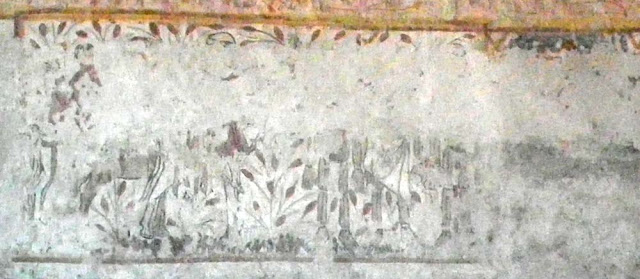The chapel of Saint Catherine at Jouhet, 16th century.
In the 13th century a story started doing the rounds in France and England. It is known as the story of the Three Living and the Three Dead in English and le dit des trios morts et des trios vifs in French. The Latin title is De Tribus Regibus Mortuis. The story is told in a call and response type of verse. In the Jouhet painting of the story the characters have 'speech bubbles' above them. In the Antigny version the poem is written below the illustrated action.
North wall of the nave in Notre-Dame, Antigny, 14th century.
(I think this is the remains of a version of the story, but am not certain.)
(I think this is the remains of a version of the story, but am not certain.)
It goes like this: One day three young noblemen were out hunting, usually hawking. To their horror they encounter three corpses which become animated and lecture them on the error of their ways. It is a moral tale about the transience of life. The corpses point out that once they were as the young men are and warn them that they had best change their hedonistic lifestyle.
The side chapel of Saint Catherine on Notre-Dame, Antigny, 15th century.
Sometimes the young men are kings, sometimes they are mounted, at others they are on foot. Very occasionally one of them is a woman.
The corpses are quite menacing. Sometimes they have grave digging tools, occasionally they carry weapons and threaten the young huntsmen.
Both the young men and their horses demonstrate varying degrees of fear with exaggerated body language. The corpses are in varying stages of decay, from semi-shrouded nudes, to worm infested cadavers, right through to skeletons.
There is a heightened awareness in this era that death is ever present, and comes to all, no matter who they are. This story also highlights that it could come at any time and you need to be ready.
Nobody really knows the origin of the story, but it appears in Western Europe at a time when disease (especially plague) and warfare is raging. It is possible that it is a transferred and transformed Buddhist story, that has made it to Europe via the Silk Road and the Ottoman trade routes.




4 comments:
Very interesting post. I wonder if the painters at Saint-Savin, Antigny and Jouhet were the same ones? Or, at least, from the same school?
Fascinating story - so does it go back to the time of the plague?
Saint Savin is much earlier than Jouhet and most of Antigny. It seems likely that Jouhet and Antigny are the same painters, commissioned by the same Lord. I'm sure the Jouhet/Antigny painters would have been familiar with Saint Savin though and that is why you see certain similarities.
Yes, both the plague and popular versions of this story probably both peak at about the same time.
Post a Comment